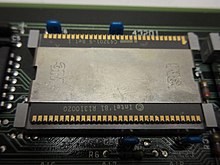|
Orphaned technology Orphaned technology refers to computer technologies that have been abandoned by their original developers. As opposed to deprecation, which tends to be a gradual shift away from an older technology to newer technology, orphaned technology is usually abandoned immediately or with no direct replacement.[1] Unlike abandonware, orphaned technology refers to both software and hardware and the practices around them. Users of orphaned technologies must often make a choice continuing to use the technology, which may become harder to maintain over time, or switch to other supported technologies, possibly losing capabilities unique to the orphaned technology.[citation needed] ReasoningWhile technology can be abandoned due to an unfavourable design or poor implementation, abandoning a technology can happen for a variety of reasons.[1] There are instances where products are phased out of the market because they are no longer viable as business ventures, such as certain medical technologies.[2] Some orphaned technologies do not suffer complete abandonment or obsolescence.[citation needed] For instance, there is the case of IBM's Silicon Germanium (SiGe) technology, which is a program that produced an in situ doped alloy as a replacement for the conventional implantation step in silicon semiconductor bipolar process. The technology was previously orphaned but was continued again by a small team at IBM so that it emerged as a leading product in the high-volume communications marketplace.[3] Technologies orphaned due to failure on the part of their startup developers can be picked up by another investor. One example is Wink, an IoT technology orphaned when its parent company Quirky filed for bankruptcy. The platform, however, continued after it was purchased by another company, Flex.[4] ExamplesSome examples of orphaned technology include:
Symbolics Inc's operating systems, Genera and OpenGenera, were twice orphaned, as they were ported from LISP machines to computers using the Alpha 64-bit CPU.[further explanation needed] User groupsUser groups often exist for specific orphaned technologies, such as The Hong Kong Newton User Group,[8] Symbolics Lisp [Machines] Users' Group (now known as the Association of Lisp Users),[9] and Newton Reference.[10] The Save Sibelius group sprang into existence because Sibelius (scorewriter) users feared the application would be orphaned after its owners Avid Tech fired most of the development team, who were thereafter hired by Steinberg to develop the competing product, Dorico.[11][12][13] See alsoReferences
|
Portal di Ensiklopedia Dunia